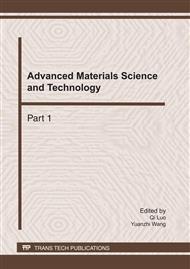[1]
T. Choe, A. Skabardonis and P. Varaiya. Freeway Performance Measurement System: Operational Analysis Tool. In Transportation Research Record: Journal of the Transportation Research Board, Vol. 1811 (2002), p.67–75.
DOI: 10.3141/1811-08
Google Scholar
[2]
C. Chen, K. Petty, A. Skabardonis, P. Varaiya and Z. Jia. Freeway Performance Measurement System: Mining Loop Detector Data. In Transportation Research Record: Journal of the Transportation Research Board, Vol. 1748 (2001), p.96–102.
DOI: 10.3141/1748-12
Google Scholar
[3]
R. L. Bertini and A. M. Myton. Use of Performance Measurement System Data to Diagnose Freeway Bottleneck Locations Empirically in Orange County, California. In Transportation Research Record: Journal of the Transportation Research Board, Vol. 1925 (2005).
DOI: 10.1177/0361198105192500106
Google Scholar
[4]
Y. Kamarianakis and P. Prastacos. Forecasting Traffic Flow Conditions in an Urban Network: Comparison of Multivariate and Univariate Approaches. In Transportation Research Record: Journal of the Transportation Research Board, Vol. 1857 (2005).
DOI: 10.3141/1857-09
Google Scholar
[5]
B. Coifman and S. Kim. Measuring Freeway Traffic Conditions with Transit Vehicles. In Transportation Research Record: Journal of the Transportation Research Board, Vol. 2121, (2009), p.90–101.
DOI: 10.3141/2121-10
Google Scholar
[6]
R. E. Turochy and B. L. Smith. Measuring Variability in Traffic Conditions by Using Archived Traffic Data. In Transportation Research Record: Journal of the Transportation Research Board, Vol. 1804 (2002), p.168–172.
DOI: 10.3141/1804-22
Google Scholar
[7]
J. L. Catbagan and H. Nakamura. Evaluation of Performance Measures for Two-Lane Expressways in Japan. In Transportation Research Record: Journal of the Transportation Research Board, Vol. 1988 (2006), p.111–118.
DOI: 10.1177/0361198106198800114
Google Scholar
[8]
A. Charnes, W. W. Cooper and E. Rhodes, Measuring the Efficiency of Decision Making Units. European Journal of Operational Research, Vol. 6 (1978), pp.429-444.
DOI: 10.1016/0377-2217(78)90138-8
Google Scholar
[9]
A. Correia and S. C. Wirasinghe. Evaluating Level of Service at Airport Passenger Terminals Review of Research Approaches. In Transportation Research Record: Journal of the Transportation Research Board, Vol. 1888 (2004), p.1–6.
DOI: 10.3141/1888-01
Google Scholar
[10]
K. M. Higgins, S. Lawphongpanich, J. F. Mahoney and Y. Yin. Evaluating Airline Service Quality by Data Envelopment Analysis, In Transportation Research Record: Journal of the Transportation Research Board, Vol. 2052 (2008), p.1–8.
DOI: 10.3141/2052-01
Google Scholar
[11]
L. Fu, J. Yang and J. Casello. Quantifying Technical Efficiency of Paratransit Systems by Data Envelopment Analysis Method. In Transportation Research Record: Journal of the Transportation Research Board, Vol. 2034 (2007), p.115–122.
DOI: 10.3141/2034-13
Google Scholar
[12]
M. G. Karlaftis. A DEA Approach for Evaluating the Efficiency and Effectiveness of Urban Transit Systems. European Journal of Operational Research, Vol. 152 (2004), p.354–364.
DOI: 10.1016/s0377-2217(03)00029-8
Google Scholar
[13]
A. K. Boame. The Technical Efficiency of Canadian Urban Transit Systems. Transportation Research Part E: Logistics and Transportation Review, Vol. 40 (2004), p.401–416.
DOI: 10.1016/j.tre.2003.09.002
Google Scholar
[14]
S. Cheon. Productive Efficiency of World Container Ports: A Global Perspective. In Transportation Research Record: Journal of the Transportation Research Board, Vol. 2062 (2008), p.10–18.
DOI: 10.3141/2062-02
Google Scholar
[15]
S. Pathomsiri. Evaluation of Airport Productivity Nonparametric Directional Output Distance Function Approach and Its Robustness. In Transportation Research Record: Journal of the Transportation Research Board, Vol. 2007 (2007), p.28–36.
DOI: 10.3141/2007-04
Google Scholar
[16]
M. J. Martinez and Y. J. Nakanishi. Productivity Analysis in Heterogeneous Operating Conditions Data Envelopment Analysis Method Applied to the U.S. Heavy Rail Industry. In Transportation Research Record: Journal of the Transportation Research Board, Vol. 1872 (2004).
DOI: 10.3141/1872-03
Google Scholar
[17]
J. B. Alam, S. H. Sikder and K. G. Goulias. Assessing the Time Lag Between Transportation Investment and Economic Development by the Data Envelopment Approach. In Transportation Research Record: Journal of the Transportation Research Board, Vol. 2932 (2005).
DOI: 10.1177/0361198105193200110
Google Scholar


